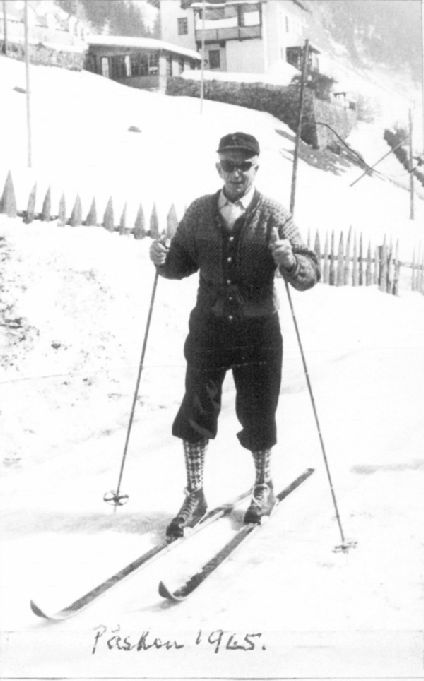
Then you could probably say that you “really lived”. That's what Jackrabbit ( the legendary Herman “Jackrabbit” Smith Johannsen) did, and I have to say I find the whole thing pretty fascinating. He even lived in Havana for an extended period of time selling engineering equipment ( “a vacuum as far as skiing was concerned”)
It's clear that while racing and going fast was a reasonably big deal for him (he was one of Norway's best all around skiers in the 1890s and was among the best skiers in the US into his 50s...), it was only part of what skiing was about for this guy. Things like adventure, lifestyle, friendship and health were pretty key.
When I first started doing some racing, I would say the intrigue was probably as much about these kinds of things as it was about racing. Sure, racing was fun and exciting, but the thrill and freedom of exploring the trails and countryside of places like Gatineau Park and Nakkertok were mesmerizing. So was skiing the narrow trails that forced “on the spot” skill development. Every day of ski training was like a new adventure. Sure beat swimming laps in a pool or running circles around a track, I'd say.
From time to time I think it's easy to lose sight of this ( like maybe when you're pondering lactate and heartrate values from your last workout, or wondering if you should cut your poles down by half a centimetre), and that's why I think it's useful to think about a guy like Jackrabbit. Then, maybe pull out some old skis and some poles with some bigger baskets and start testing your skill skiing around trees that require you to actually grab hold of them and swing yourself around to get down the hill. That's when I remember why cross country skiing rules all of it.
Jackrabbit isn't exactly in People magazine or on MSN, so you have to do some digging to find out about him. I even tried to locate something called the Jackrabbit Museum a few years ago (it was located in the house where he lived in Piedmont), but sadly, discovered that it had closed. Personally, I've got a biography written by his daughter, and I have a documentary on DVD made by the National Film Board (which, by the way, has an amazing clip of him riding in the back of a station wagon, smoking a big fat cigar, and talking about a deer that he shot 40 years ago. He turned the skin into sleeping bags which were still being used at the time of filming). Also, thanks to my teammate Sheila, I now have his autograph in a Norwegian book that he used to own.
There is another book available which I have read but don't own my own copy. There is some limited information available on the Internet, and I have kind of been trying to track down some old CBC interviews which aired on the radio show “Fresh Air”. If anyone out there reads this and knows where I could find out more, I'd love to hear about it.
I'll finish by providing some fun stuff I found in some of the books and articles that I have managed to locate.
Ski competitions organized by Jackrabbit included the following events:
Cross Country (more or less like we do today, but a bit more primitive)
Downhill
Slalom
Jumping
The Bushwack: “the piece de resistance” always held at some new and unexpected spot. At a given signal, the whole horde would set off at once, battling their way down through the bush without a trail, colliding with trees and each other, losing their poles, falling and righting themselves, and finally reaching the finish line in a flurry of excitement”. (Johannsen, p. 238-239)
“At the outbreak of the Second World War, he offered his services for training the troops but was turned down because he was 65 years old, even though he could have run 99 percent of the recruits into the ground. Herman was annoyed but thought that he might still be accepted if he could prove that he was in good physical condition. He maintained a log of his mileage while keeping the Maple Leaf Trail open (meaning that this mileage was accumulated in a pretty tough way, I think). His record: 1940-41-980 miles; 1941-42-960 miles; 1942-43-1155 miles. He kept reporting to the army brass and the brass kept repeating that his age was against him. After five years, they finally won the war without him.” (William L. Ball)
“ Bursting out of the upper slopes in to a small clearing, he suddenly found himself straddling a the fire ranger's telephone line....As if this were a natural occurrence, he rode it for some twenty feet, getting higher and higher above the ground until finally, losing momentum, he flipped off, dropped some ten feet to the ground, landed on his feet and continued down the hill, albeit a bit bow-legged.” (Johannsen p.188).
“Lessons are fine for those who have the the money and the time to spend, but after you've found your ski legs, then come with me on a trip in the bush. When you rattle down a lumber road, and suddenly meet head-on with a team of horses and a sleighload of logs, that's when you learn to ski in a bit of a hurry” (Johannsen p. 178)
“...as coach of the Canadian team (1932 Olympics), he had an important duty to perform. His “boys” need some exercise, and he was determined they should really get a feel for the Adirondacks as their initiation into the Olympics. “Besides, it will be good for their legs”. So he and Louis, two days before the their scheduled race, took the Canadians on a full day's trip up Mt. Marcy....”. Reading on, you discover that when it got dark they still had 10 miles to ski. Jackrabbit was also in his late 50's at that time...( Johannsen p. 204)
Sources:
The Legendary Jackrabbit Johannsen, by Alice E. Johannsen. McGill-Queen's University Press, 1993.
The fabulous “Jack Rabbit”, by William L. Ball. Nordic World Magazien, November, 1975. Avaialble at: http://www.cccski.com/main.asp?cmd=doc&ID=2059&lan=0


